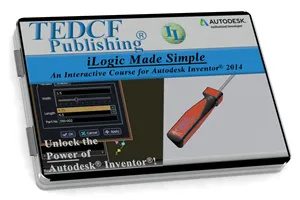iLogic creates parts, assemblies, and drawings with a click of a button. This course shows you how!
The Inventor 2014: iLogic Made Simple course does just what the title implies. It simplifies iLogic and gives you the ability to unlock the power of this amazing tool. You don't need to be a programmer to use it. Follow the simple steps in the course and you'll be able to create assemblies, components, and drawings with a single click of a button.
So what is iLogic? Simply speaking, iLogic allows you to setup a series of commands and execute them. So it's a little like a macros, but more powerful. You can setup a series of commands to draw sketches, create features, create a whole part file, or even an assembly with components. You just need to know all the steps you would manually take to do these tasks. You also need to know how to manually use Inventor commands and how they work. So any task you perform in Autodesk Inventor can be performed using iLogic.
Why don't you need to be a programmer? Even though iLogic uses a simple programming language you don't need to know how to program. If you know how to use Inventor and you can copy and paste you're well on your way. This course shows you how to leverage programming code that comes with Inventor. You'll learn how the code works by practicing with it, and learn how to store it so that you can use it later. As you proceed through the course you'll develop an arsenal of code you can use to write your own iLogic. When you try it you'll find it's easier than it sounds.
How extensive is this training? It starts with the basics and progressively builds to an extremely advanced level. At this point you will be able to independently create your own iLogic. By the end of the course you will have created iLogic that creates assemblies and its components, keeps inventory of all the components, reuses existing components in new assemblies, creates all the component and assembly drawings, and organizes all the component and assembly files in folders. This will be done with a single click of a button. No other iLogic training course comes close to covering this much.
Even though it covers a lot of concepts the true focus of the course is to teach you to teach yourself. The things you can do with iLogic are unlimited, and even though you will have used it to do what the course shows you, it's more important that you learn how to use iLogic in your own projects. So you will learn how to extend your knowledge beyond the scope of course.
68 Lessons & 67 Tips (Listed Below)
6.5 hours of instruction
You can also browse through the lessons from the following Inventor 2014 courses and watch sample lessons.
Inventor 2014: Solid Modeling Inventor 2014: Assemblies and Advanced Concepts Inventor 2014: 2D Drafting and Customization Inventor 2014: Sheet Metal Design Inventor 2014: Tube and Pipe Routed Systems Inventor 2014: Inventor Studio Made Simple Inventor 2014: iLogic Made SimpleOur Inventor courses require No Installation. You can watch them on any device connected to the internet.
You will receive an email containing your User Name and Password. Login to your account and start learning. It's that easy.
While you're logged into your account you can download files used in the courses, watch lessons, and practice the tasks taught in the lessons. Keep in mind that you will use your installation of Inventor to practice.
Get your Inventor 2014 training now. You can start learning in minutes.
Autodesk Inventor® 2014:
iLogic Made Simple
No Installation Required
Watch from any device connected to the internet.

$84.95 - $169.95
Watch Sample Lessons
Watch the first hour of the Solid Modeling course for Autodesk Inventor 2014.
 Click to Watch!
Click to Watch!iLogic Made Simple
6.5 hours of instruction
Lessons
Introduction
ILMS-Tip-1
iLogic Parameters
ILMS-Tip-2
Preparing Parts for iLogic
ILMS-Tip-3
iLogic Rule Basics
ILMS-Tip-4
iLogic Suppression
ILMS-Tip-5
Reusing Code
ILMS-Tip-6
Strategy for Using iLogic
ILMS-Tip-7
Mastering Snippets
ILMS-Tip-8
iLogic Assemblies
ILMS-Tip-9
Linking Imported Parameters
ILMS-Tip-10
Troubleshooting Rules
ILMS-Tip-11
Working with String Parameters
ILMS-Tip-12
Mastering Case Statements
ILMS-Tip-13
Expanding Rule Functionality
ILMS-Tip-14
Nested Case Statements
ILMS-Tip-15
iLogic Forms
ILMS-Tip-16
Creating iLogic Forms
ILMS-Tip-17
Configuring Controls
ILMS-Tip-18
Filename Parameters
ILMS-Tip-19
Linking Filename Parameters
ILMS-Tip-20
Control Testing Strategies
ILMS-Tip-21
Automatically Save Files
ILMS-Tip-22
Point Assembly to Component Files
ILMS-Tip-23
Replacing Parts with iLogic
ILMS-Tip-24
Master Rules
ILMS-Tip-25
Algorithms
ILMS-Tip-26
Triggers
ILMS-Tip-27
Redundant Files
ILMS-Tip-28
Pre-Existing Files
ILMS-Tip-29
Building Descriptions and Titles
ILMS-Tip-30
Snippet Workflow
ILMS-Tip-31
Opening Excel Files
ILMS-Tip-32
While Loops
ILMS-Tip-33
Populating Excel Worksheets
ILMS-Tip-34
Updating Master Rules
ILMS-Tip-35
Multi-Line Messages
ILMS-Tip-36
Searching Tables
ILMS-Tip-37
Trick for Stopping Rules
ILMS-Tip-38
Preventing Duplicate Records
ILMS-Tip-39
Stopping Error Messages
ILMS-Tip-40
Updating Assembly Components
ILMS-Tip-41
Cleaning Up Your Code
ILMS-Tip-42
Building Assemblies and Testing
ILMS-Tip-43
Automating Mechanical Drawings
ILMS-Tip-44
Testing Rules on Drawings
ILMS-Tip-45
Control Section Cutting Lines
ILMS-Tip-46
Break Views and Detail Circles
ILMS-Tip-47
Automating Broken Views
ILMS-Tip-48
Broken View Rule Details
ILMS-Tip-49
Break Multiple Views
ILMS-Tip-50
Dimensions on Suppressed Features
ILMS-Tip-51
Determining Rule Placement
ILMS-Tip-52
Using Shared Variables
ILMS-Tip-53
Robust Shared Variables
ILMS-Tip-54
Testing Shared Variable Rules
ILMS-Tip-55
Running idw Rules from Assemblies
ILMS-Tip-56
Saving Drawing Files
ILMS-Tip-57
Change View File Reference
ILMS-Tip-58
Update Reference File
ILMS-Tip-59
Passing iProperties and Parameters
ILMS-Tip-60
Replacing Drawing References
ILMS-Tip-61
Assembly Drawing Rules
ILMS-Tip-62
Passing Assy to Drawings
ILMS-Tip-63
One Click Assy Parts & Drawings
ILMS-Tip-64
Creating Input List Radio Boxes
ILMS-Tip-65
External Rules
ILMS-Tip-66
Global Forms
ILMS-Tip-67
Conclusion
